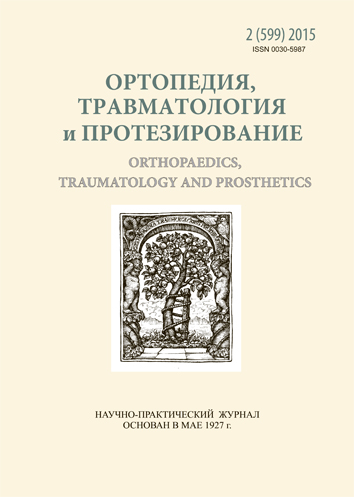Bone densitometry in clinical practice
DOI:
https://doi.org/10.15674/0030-598720152100-107Keywords:
bone mineral density, spine, hip joint, forearmAbstract
In this paper an information on the features of bone densitometry on DEXA devices was presented, and basic errors that can occur during the execution of the study or assessment of patients data after their examination were specified. Bone densitometry is an important informative method of examination allowing to detect not only qualitative and quantitative indicators of bone condition but to perform also monitoring which is important after medicament therapy for evaluation of effectiveness of treatment of osteoporosis. The method makes it possible to detect deformations and fractures of the vertebral bodies as well as to assess quantitatively change of their shape. For measurement of bone mineral density on the lumbar spine they use AP-projection LI–LIV. If in the area of the research there are vertebrae with destructive disorders they exclude them from the analysis and carry out diagnostics according two vertebral bodies without any violations. The difference between the vertebral bodies should not be 1 SD in accordance with T-criterion. Orthopedic programs incorporated into the device make it possible to describe bone tissue condition in the area of contact with the implant after arthroplasty. Quantitative evaluation of bone mass adjacent to the implant implanted into the hip joint they performed in Gruen zones which they determine in frontal plane with the prone position of a patient after 2–3 weeks after arthroplasty and consider as basic assessment. One may assess the condition of the entire skeleton, fat and fat-free body mass which is important for examination of children and patients with endocrine disorders, identifying sarkopenia, in the case of obesity, malabsorption syndrome and so on. Interpreting the results one should also take into account some features of this method of patient examination for reducing the risk of diagnostic errors.References
- Deficiency and deficiency of vitamin D: epidemiology, diagnosis, prevention and treatment /ed. V. Povoroznyuk, P. Pludovski. - Donetsk: O. Zaslavsky,2014. — 262 р.
- Osteoporosis: epidemiology, clinical features, diagnosis and treatment / under. Ed. NA Korzh, V. Povoroznyuk, Dedukh NV, IA Zupanets. - H .: Golden Pages, 2002. — 648 p.
- Povoroznyuk V. Vitamin D deficiency among school children / VV Povoroznyuk, NI Balatskiy // Perinatology and pediatrics. — 2012. — № 3. — P. 117–120.
- Official Positions of the International Society for Clinical Densitometry [web source]. — 2007. — Access mode: http://www.iscd.org.
- Official Positions of the International Society of Clinical Densitometry. — 2013. — [web source]. — Access mode: www.ISCD.org14.
- Features X-ray bone densitometry in clinical practice. Guidelines / IA Skripnikova, LA Scheplyagina VE Novikov [et al.] // Osteoporosis and osteopathy.. — 2010. — Т. 3, № 1. — P. 23–34.
- Skripnikova IA Dual-energy X-ray absorptiometry in clinical research and practice real¬noy. Questions reproducibility and quality / I.A. Skripnikova, L.M. Murashko, E.S. Abirova // Osteoporosis and osteopathy. — 2014. — № 1. — P. 43–46.
- Glassman A. H. New femoral designs: do they influence stress shielding? / A. H. Glassman, J. D. Bobyn, M. Tanzer // Clin. Orthop. Relat. Res. — 2006. — Vol. 45. — P. 64–74.
- Сourse of bone mineral density changes around cementless Zweymüller total hip arthroplasty. A 4-year follow-up study / P. Korovessis, V. Droutsas, G. Piperos, A. Michael [et al.] // Arch. Orthop. Trauma Surg. — 1997. — Vol. 116. — P. 60–65.
- Rodionova S.S. Effect of alendronate in combination with alfacalcidol on the formation of the biological stability of the femoral endoprosthesis in patients with systemic osteoporosis / S.S. Rodionova, T.N. Turgumbaev // Osteoporosis and Osteopenia. — 2013. — № 1. — P. 24–28.
- Effect of alendronate on periprosthetic bone loss after cemented primary total hip arthroplasty: a prospective randomized study / A. Nehme, G. Maalouf, J. L. Tricoire [et al.] // Rev. Chir. Orthop. Rep. App. Moteur. — 2003. — Vol. 89. — P. 593–598.
- Higher failure rate and stem migration of an uncemented femoral component in patients with femoral head osteonecrosis than in patients with osteoarthrosis / R. Randle, M. Hungerford, W. Materna [et al.] // Acta Orthop. Scand. — 2005. — Vol. 76, № 1. — P. 49–55.
- Gruen T. A. Modes of failure of cemented stem-type femoral components: a radiographic analysis of loosening / T. A. Gru¬en, G. M. McNeice, H. C. Amstutz // Clin Orthop Relat Res. — 1979. — Vol. 141. — P. 17–27.
- Osteoporosis. Diagnosis, prevention and treatment. Clinical guidelines / ed. M. Lesniak, LI Benevolenskaya. - M .: GEOTAR Media. 2010. — 272 p.
Downloads
How to Cite
Issue
Section
License
Copyright (c) 2015 Volodymyr Radchenko, Sergey Kosterin, Ninel Dedukh, Yevgeny Pobel

This work is licensed under a Creative Commons Attribution 4.0 International License.
The authors retain the right of authorship of their manuscript and pass the journal the right of the first publication of this article, which automatically become available from the date of publication under the terms of Creative Commons Attribution License, which allows others to freely distribute the published manuscript with mandatory linking to authors of the original research and the first publication of this one in this journal.
Authors have the right to enter into a separate supplemental agreement on the additional non-exclusive distribution of manuscript in the form in which it was published by the journal (i.e. to put work in electronic storage of an institution or publish as a part of the book) while maintaining the reference to the first publication of the manuscript in this journal.
The editorial policy of the journal allows authors and encourages manuscript accommodation online (i.e. in storage of an institution or on the personal websites) as before submission of the manuscript to the editorial office, and during its editorial processing because it contributes to productive scientific discussion and positively affects the efficiency and dynamics of the published manuscript citation (see The Effect of Open Access).














